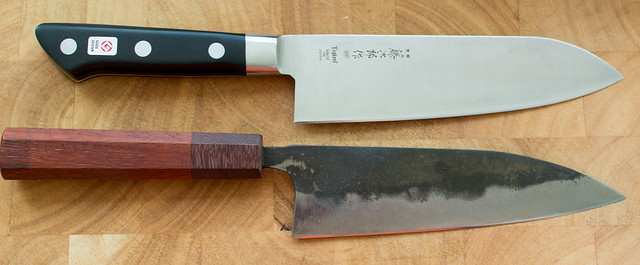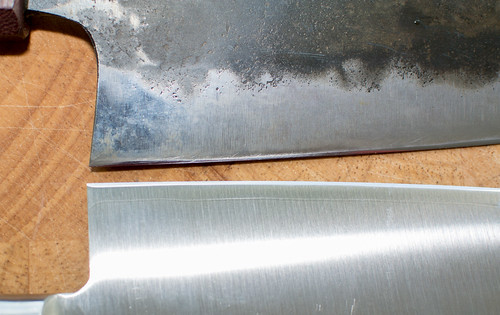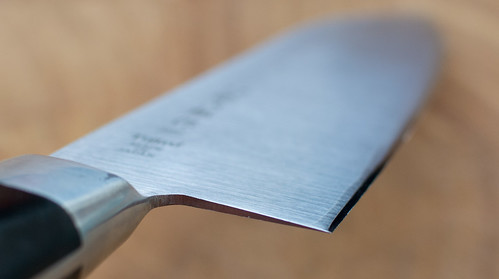This is going to be a short one.
A lot has been discussed about Tojiro DP knives. I was recently on a search for decent lower price knives and after going through many options I decided to give Tojiro DP a try. The intention is to be 3-4 knife in total for the kitchen in our cottage and would work well and would not be intimidating to inexperienced users.
I decided to start with just one knife first and see how I like it. It is made out of VG-10 which gets mixed feedback around here. I know that those mixed feelings were mostly caused by the tendency of Shun knives to chip (I have one of those too and yes - it does chip). On the other hand VG-10 from Tojiro got positive feedback from users - so I had to try it myself
As I also have a Carter funayuki in nearly the same size (167 mm) I though it could be interesting to compare the two briefly.
Two very different knives design and philosophy wise, though they both perform well.

Specifications:
Tojiro:
- weight:186 g
- blade length: 170 mm
- blade height at the heel: 46mm
- blade thickness at the heel: 1.9 mm
- blade thickness 1/2 way towards the tip: 1.8 mm
- blade thickness 1cm from the tip: 1.0 mm
- VG-10 clad with soft stainless steel
Carter:
- weight: 114 g
- blade length: 167 mm
- blade height at the heel: 47 mm
- blade thickness at the handle: 3.8 mm
- blade thickness at the heel: 2.9mm
- blade thickness 1/2 way towards the tip: 1.6mm
- blade thickness 1cm from the tip: 0.9 mm
- white #1 clad with iron
The Tojiro is quite heavy what goes mainly to the big thick bolster and full tang handle. I find that the knife handling would improve if some weight could be reduced at the handle.
There is not much of distal taper on the Tojiro.

The knife was delivered well sharpen albeit with a low grit as the edge was quite toothy. But there were no apparent problems - the grind and edge were all consistent, the handle flush with the bolster and pins. I used the knife a little and then gave it a workout on Gesshin 2000 and 6000. I can only say I had no problems to sharpen it and it did not take too long either. The knife had just about perfect balance of fine edge and tooth - it would shave arm hair with no resistance and it would bite into tomato skin with 0 resistance. Really nice edge to use in the kitchen. To de-burr the edge (on stone a'la Jon) was not problem either.
The profile of the Tojiro shows quite a bit of belly - it would seem that it is more meant for push-cutting than chopping, though I did not have problems to chop with it (even with the tip). The tip is not too pointy and that would be a minus point for me as I like to use it for fine work - something the Carter is much more suitable for.
Even grind and edge on the Tojiro (and surprisingly little/weak patina on the Carter after about 6 months)

The bevels of the knife are relatively flat and were finished on some aggressive material - even though that the scratch pattern is very even and not too obvious - running with your finger along the blade face gives very 'sharp' impression. I would guess that sanding the blade a bit to smooth the face out would be a good idea to decrease the drag.
Choil has relatively sharp edges on the Tojiro and could use a little sanding.

I am also happy to say that the blade is reasonably thin and I do not see the need to thin it right away. The grind feels more flat than the one on the Carter which does slide better through onions than the Tojiro.

The handles are on the blocky side and rather heavy (full tang, large steel bolster), but still sits reasonably in hand. The weight of the handle means, than the Santoku has the balanced point on the bolster, which is OK, but my personal preference would be 1-2 cm in from of the bolster for this type of knife.
Summary:
Given than I payed around 50 (that would be around 1/6th of the Carter) for this knife it is hard to find some fault on it. The steel takes a great edge (I need to use it longer to see how long it holds that edge, still fine after few weeks of home use) relatively easily. It really is a substantial step up from German knives that come for about the same (or actually more) cash. I would not hesitate to recommend them to anyone who is looking for for good knives on budget.
A lot has been discussed about Tojiro DP knives. I was recently on a search for decent lower price knives and after going through many options I decided to give Tojiro DP a try. The intention is to be 3-4 knife in total for the kitchen in our cottage and would work well and would not be intimidating to inexperienced users.
I decided to start with just one knife first and see how I like it. It is made out of VG-10 which gets mixed feedback around here. I know that those mixed feelings were mostly caused by the tendency of Shun knives to chip (I have one of those too and yes - it does chip). On the other hand VG-10 from Tojiro got positive feedback from users - so I had to try it myself
As I also have a Carter funayuki in nearly the same size (167 mm) I though it could be interesting to compare the two briefly.
Two very different knives design and philosophy wise, though they both perform well.

Specifications:
Tojiro:
- weight:186 g
- blade length: 170 mm
- blade height at the heel: 46mm
- blade thickness at the heel: 1.9 mm
- blade thickness 1/2 way towards the tip: 1.8 mm
- blade thickness 1cm from the tip: 1.0 mm
- VG-10 clad with soft stainless steel
Carter:
- weight: 114 g
- blade length: 167 mm
- blade height at the heel: 47 mm
- blade thickness at the handle: 3.8 mm
- blade thickness at the heel: 2.9mm
- blade thickness 1/2 way towards the tip: 1.6mm
- blade thickness 1cm from the tip: 0.9 mm
- white #1 clad with iron
The Tojiro is quite heavy what goes mainly to the big thick bolster and full tang handle. I find that the knife handling would improve if some weight could be reduced at the handle.
There is not much of distal taper on the Tojiro.

The knife was delivered well sharpen albeit with a low grit as the edge was quite toothy. But there were no apparent problems - the grind and edge were all consistent, the handle flush with the bolster and pins. I used the knife a little and then gave it a workout on Gesshin 2000 and 6000. I can only say I had no problems to sharpen it and it did not take too long either. The knife had just about perfect balance of fine edge and tooth - it would shave arm hair with no resistance and it would bite into tomato skin with 0 resistance. Really nice edge to use in the kitchen. To de-burr the edge (on stone a'la Jon) was not problem either.
The profile of the Tojiro shows quite a bit of belly - it would seem that it is more meant for push-cutting than chopping, though I did not have problems to chop with it (even with the tip). The tip is not too pointy and that would be a minus point for me as I like to use it for fine work - something the Carter is much more suitable for.
Even grind and edge on the Tojiro (and surprisingly little/weak patina on the Carter after about 6 months)

The bevels of the knife are relatively flat and were finished on some aggressive material - even though that the scratch pattern is very even and not too obvious - running with your finger along the blade face gives very 'sharp' impression. I would guess that sanding the blade a bit to smooth the face out would be a good idea to decrease the drag.
Choil has relatively sharp edges on the Tojiro and could use a little sanding.

I am also happy to say that the blade is reasonably thin and I do not see the need to thin it right away. The grind feels more flat than the one on the Carter which does slide better through onions than the Tojiro.

The handles are on the blocky side and rather heavy (full tang, large steel bolster), but still sits reasonably in hand. The weight of the handle means, than the Santoku has the balanced point on the bolster, which is OK, but my personal preference would be 1-2 cm in from of the bolster for this type of knife.
Summary:
Given than I payed around 50 (that would be around 1/6th of the Carter) for this knife it is hard to find some fault on it. The steel takes a great edge (I need to use it longer to see how long it holds that edge, still fine after few weeks of home use) relatively easily. It really is a substantial step up from German knives that come for about the same (or actually more) cash. I would not hesitate to recommend them to anyone who is looking for for good knives on budget.




